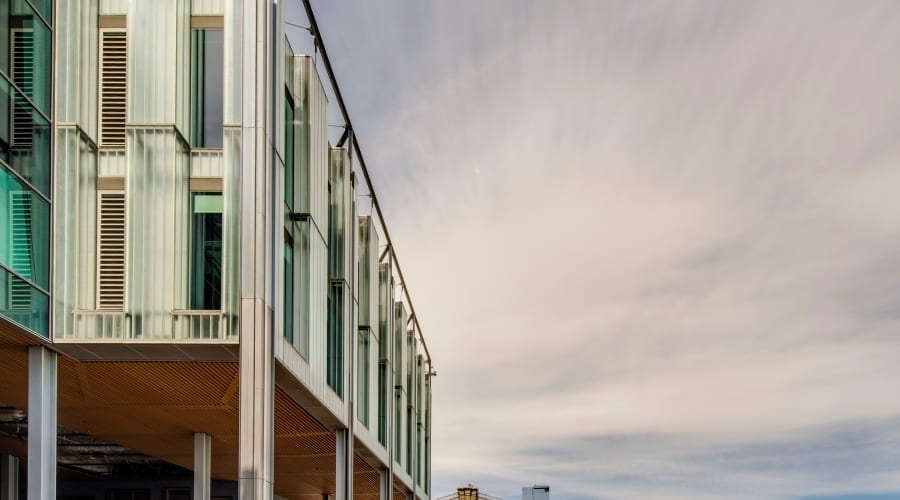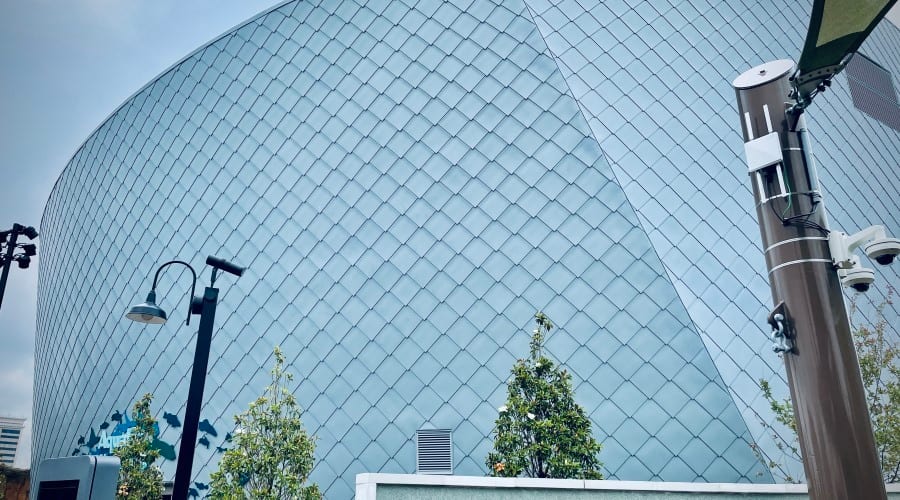Building teams are increasingly being asked to examine the carbon footprint as they evaluate materials and products to meet projects’ performance requirements and code compliance. For wall cladding and roofing systems, architectural zinc’s inherent metallic properties can help reduce buildings’ operational carbon footprints, and improve their energy-efficient, climate-resilient, long-lasting performance.
The Mississippi Aquarium features three main buildings clad in a distinctive, scaled, offset, overlapping pattern of 16,000 diamond flat-lock wall tiles fabricated with more than 81,400 lbs. of Type 1 Architectural Rolled SHG pre-patina blue-grey zinc. With a potential lifespan of 100 years or more, this resilient, natural metal supports both the Aquarium’s economic and environmental goals. Flat-lock panels meet the project’s multiple performance requirements to stand up to flooding, high winds, fade, corrosion and rust in the hurricane-prone area. Photo courtesy of Mississippi Aquarium and RHEINZINK.
Carbon Concerns
Carbon emissions, specifically emissions of carbon dioxide (CO2), are identified as greenhouse gases (GHGs). GHG emissions typically are measured in terms of “carbon equivalent” (CO2eq) and Global Warming Potential (GWP). A 100-year GWP is standard, which represents the energy absorbed by a CO2eq GHG over 100 years.
The internationally recognized Reporting Standard by Greenhouse Gas Protocol categorizes emissions reporting into three “scopes.”
- Scope 1 are direct emissions associated with the consumption of fuel, including transportation, equipment operation and facility operation.
- Scope 2 are indirect emissions associated with purchased energy for electricity, heating and cooling.
- Scope 3 are indirect emissions for activities not included in Scope 1 or 2 that are listed in 15 categories, including waste generated in operations and end-of-life treatment of sold products.1
Building teams have the opportunity to help significantly lower GHG emissions across all three scopes.
The Carbon Smart Materials Palette, an Architecture 2030 Project that provides attribute-based design and material guidance, stated, “It is anticipated that embodied carbon will be responsible for 72 percent of the carbon emissions associated with global new construction between now and 2030.” 2 Considering a typical building is in use for 50 to 100 years, the projects being designed and constructed today will be completing their operational lifecycles around 2073, and into the 2120s.
Material transparency allows building teams to make more informed decisions. Assisting with evaluation, manufacturers can provide life cycle assessments (LCAs), environmental product declarations (EPDs), Cradle to Cradle certifications and other documentation. Where industry average EPDs and other data previously was acceptable, product-specific and facility-specific data are increasingly requested for more accurate selection criteria and project sustainability reporting.on.
The Rockaway Hotel in Queens, New York, is part of a planned redevelopment following the damage caused by Hurricane Sandy. Clad in resilient Architectural Rolled SHG pre-patina zinc wall panels, the material requires minimal maintenance and offers a potential lifespan 100 years or more. At the end of its use on the hotel, the natural zinc material is 100% recyclable. Throughout the hotel's long lifespan, the zinc cladding's dynamic exterior appearance will evolve as formed by the unique local, coastal climate. Photo courtesy of B&B Sheet Metal and RHEINZINK.

Carbon-Reduced, High-Quality Zinc
A natural metal, zinc is the 24th most abundant element in the Earth’s crust and the fourth most-used metal in the world.3 For architectural applications, raw zinc material is smelted, cast as a material of uniform and certified quality, and wound as a coil in one continuous operation. Rolled zinc sheet is produced by alloying Special High-Grade (SHG), 99.995 percent pure zinc with minute quantities of copper, titanium and aluminum. The alloy composition provides the material the necessary strength, while allowing the architectural product to be easily shaped.
As material demands and energy costs rise, energy-efficient production maximizes both economic and environmental resources. Because zinc has a low melting point of 784 degrees Fahrenheit, it takes less energy to process it than other metals and materials. For comparison, aluminum melts at 1220F and steel at 2500F.
The International Zinc Association (IZA) provides practical guidance on calculating the carbon footprint for SHG zinc in compliance with ISO 14040 and 14044, as well as with the Product Life Cycle Accounting and Reporting Standard by Greenhouse Gas Protocol.4 As a global average, the carbon footprint GWP for primary SHG zinc production was calculated by the IZA to be 3.64 kg CO2eq per 1 kg (8.02 lbs. CO2eq per 1 lbs.).5 Many IZA member companies have committed to climate change policies to reach net-zero Scope 1 and 2 GHG emissions by 2050. An increasing number also are working on Scope 3 targets.6
One IZA member7 has further lowered the carbon footprint of its SHG zinc product to achieve a 100-year GWP of 1.85 kg CO2eq per 1 kg (4.08 lbs. CO2eq per 1 lbs.). This savings was gained through energy-efficient production practices that rely on electricity largely generated from renewable sources including water and wind power. Additionally, recycled zinc material is used in its production. This investment reduced the product’s impact by 54 percent and saves more than 36,000 metric tons (39,283 U.S. tons) of CO2eq each year, equivalent to the GHG emissions of a small town with 5,400 people. Quantifying this, a 1 m2 area of standing-seam zinc material would have 12 kg CO2eq (26.5 lbs. per 10.8 ft2). This low-carbon architectural zinc material is now available in North America.
Oregon State University's Gladys Valley Marine Studies Building is designed and built to meet LEED® Gold criteria, withstand a 9+ earthquake, survive an XXL tsunami event and be repairable after a large tsunami event. In this severe marine environment, Type 1 Architectural Rolled SHG architectural zinc roofing and wall cladding meets high-performance requirements and harsh conditions, and is a 100% recyclable component with a potential lifespan of up to 100 years. Over time, the Marine Studies Building's zinc roofing and cladding will develop a self-healing, corrosion-resistant patina uniquely shaped by the Yaquina Bay climate. Photo courtesy of Josh Partee Architectural Photographer and RHEINZINK.

